Lights Over Lapland is excited to announce that we now have TWO aurora webcams covering nearly a 200° view of Abisko National Park in Sweden! Watch the auroras dance live, all season long here. | | |
SOLAR WIND, INCOMING: A stream of solar wind is expected to brush Earth's magnetic field on March 8th. The gaseous material is flowing from a northern hole in the sun's atmosphere. Although much of the windy stream will sail north of our planet, its grazing effect may nevertheless spark bright auroras around the Arctic Circle. Free: Aurora Alerts.
THE WORSENING COSMIC RAY SITUATION: Cosmic rays are bad–and they're getting worse. That's the conclusion of a new paper just published in the research journal Space Weather. The authors, led by Prof. Nathan Schwadron of the University of New Hampshire, show that radiation from deep space is dangerous and intensifying faster than previously predicted.
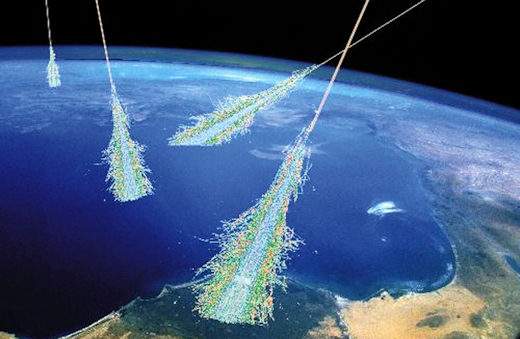
The story begins four years ago when Schwadron and colleagues first sounded the alarm about cosmic rays. Analyzing data from the Cosmic Ray Telescope for the Effects of Radiation (CRaTER) instrument onboard NASA's Lunar Reconnaissance Orbiter (LRO), they found that cosmic rays in the Earth-Moon system were peaking at levels never before seen in the Space Age. The worsening radiation environment, they pointed out, was a potential peril to astronauts, curtailing how long they could safely travel through space.
This figure from their original 2014 paper shows the number of days a 30-year old male astronaut flying in a spaceship with 10 g/cm2 of aluminum shielding could go before hitting NASA-mandated radiation limits:
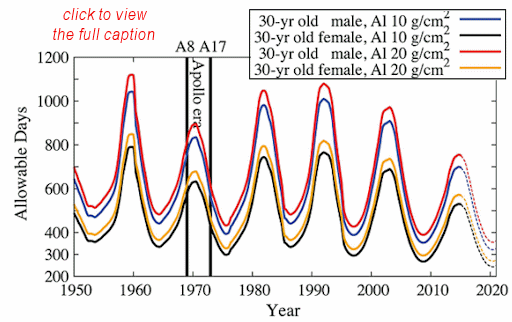
In the 1990s, the astronaut could spend 1000 days in interplanetary space. In 2014 … only 700 days. "That's a huge change," says Schwadron.
Galactic cosmic rays come from outside the solar system. They are a mixture of high-energy photons and sub-atomic particles accelerated toward Earth by supernova explosions and other violent events in the cosmos. Our first line of defense is the sun: The sun's magnetic field and solar wind combine to create a porous 'shield' that fends off cosmic rays attempting to enter the solar system. The shielding action of the sun is strongest during Solar Maximum and weakest during Solar Minimum–hence the 11-year rhythm of the mission duration plot above.
The problem is, as the authors note in their new paper, the shield is weakening: "Over the last decade, the solar wind has exhibited low densities and magnetic field strengths, representing anomalous states that have never been observed during the Space Age. As a result of this remarkably weak solar activity, we have also observed the highest fluxes of cosmic rays."
Back in 2014, Schwadron et al used a leading model of solar activity to predict how bad cosmic rays would become during the next Solar Minimum, now expected in 2019-2020. "Our previous work suggested a ~ 20% increase of dose rates from one solar minimum to the next," says Schwadron. "In fact, we now see that actual dose rates observed by CRaTER in the last 4 years exceed the predictions by ~ 10%, showing that the radiation environment is worsening even more rapidly than we expected." In this plot bright green data points show the recent excess:

The data Schwadron et al have been analyzing come from CRaTER on the LRO spacecraft in orbit around the Moon, which is point-blank exposed to any cosmic radiation the sun allows to pass. Here on Earth, we have two additional lines of defense: the magnetic field and atmosphere of our planet. Both mitigate cosmic rays.
But even on Earth the increase is being felt. Spaceweather.com and the students of Earth to Sky Calculus have been launching space weather balloons to the stratosphere almost weekly since 2015. Sensors onboard those balloons show a 13% increase in radiation (X-rays and gamma-rays) penetrating our planet's atmosphere:

X-rays and gamma-rays detected by these balloons are "secondary cosmic rays," produced by the crash of primary cosmic rays into Earth's upper atmosphere. They trace radiation percolating down toward our planet's surface. The energy range of the sensors, 10 keV to 20 MeV, is similar to that of medical X-ray machines and airport security scanners.
How does this affect us? Cosmic rays penetrate commercial airlines, dosing passengers and flight crews so much that pilots are classified by the International Commission on Radiological Protection as occupational radiation workers. Some research shows that cosmic rays can seed clouds and trigger lightning, potentially altering weather and climate. Furthermore, there are studies ( #1, #2, #3, #4) linking cosmic rays with cardiac arrhythmias in the general population.
Cosmic rays will intensify even more in the years ahead as the sun plunges toward what may be the deepest Solar Minimum in more than a century. Stay tuned for updates.
FLIGHT OF THE EASTERNAUTS: Easter is coming early this year: April 1, 2018--hence the flight of the Easternauts. To support their cosmic ray monitoring program, the students of Earth to Sky Calculus have flown a payload-full of bunnies to the edge of space:
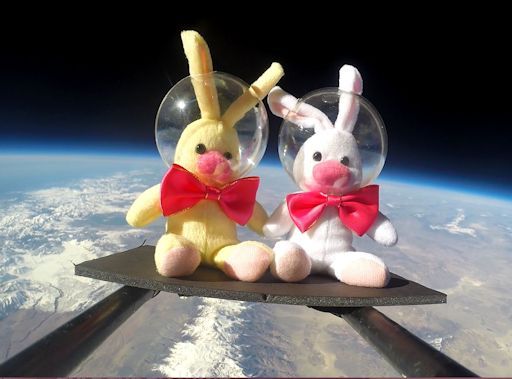
You can have one for $49.95. (Space helmet included!) They make great Easter gifts for young scientists, and all proceeds support STEM education. Each bunny comes with a greeting card showing the Easternaut in flight and telling the story of its journey to the stratosphere and back again.
Far Out Gifts: Earth to Sky Store
All proceeds support hands-on STEM education
Realtime Space Weather Photo Gallery
Realtime Aurora Photo Gallery
Every night, a network of
NASA all-sky cameras scans the skies above the United States for meteoritic fireballs. Automated software maintained by NASA's Meteoroid Environment Office calculates their orbits, velocity, penetration depth in Earth's atmosphere and many other characteristics. Daily results are presented here on Spaceweather.com.
On Mar. 5, 2018, the network reported 10 fireballs.
(10 sporadics)
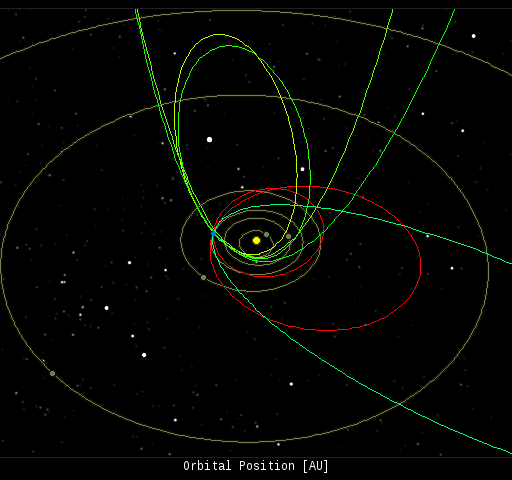
In this diagram of the inner solar system, all of the fireball orbits intersect at a single point--Earth. The orbits are color-coded by velocity, from slow (red) to fast (blue). [Larger image] [movies]
Potentially Hazardous Asteroids (
PHAs) are space rocks larger than approximately 100m that can come closer to Earth than 0.05 AU. None of the known PHAs is on a collision course with our planet, although astronomers are finding
new ones all the time.
On March 5, 2018 there were 1882 potentially hazardous asteroids.
 |
Recent & Upcoming Earth-asteroid encounters: | Asteroid | Date(UT) | Miss Distance | Velocity (km/s) | Diameter (m) |
| 2014 EY24 | 2018-Feb-27 | 14.8 LD | 8 | 54 |
| 2018 DT | 2018-Feb-27 | 4.2 LD | 2.6 | 13 |
| 2018 CU14 | 2018-Feb-27 | 5.5 LD | 4.4 | 11 |
| 2015 BF511 | 2018-Feb-28 | 11.7 LD | 5.7 | 39 |
| 2018 DW1 | 2018-Mar-01 | 3.9 LD | 12.2 | 15 |
| 2018 DE1 | 2018-Mar-01 | 15.3 LD | 6.6 | 28 |
| 2018 DV1 | 2018-Mar-02 | 0.3 LD | 6.6 | 7 |
| 2018 DU1 | 2018-Mar-02 | 5.1 LD | 6.3 | 10 |
| 2018 DS1 | 2018-Mar-03 | 16.4 LD | 16.3 | 37 |
| 2018 DC | 2018-Mar-03 | 9.3 LD | 8.2 | 40 |
| 2018 DZ3 | 2018-Mar-03 | 10.6 LD | 9.7 | 18 |
| 2018 DC4 | 2018-Mar-04 | 3.3 LD | 3.9 | 12 |
| 2003 EM1 | 2018-Mar-07 | 16.6 LD | 8 | 45 |
| 2017 VR12 | 2018-Mar-07 | 3.8 LD | 6.3 | 289 |
| 2018 BK7 | 2018-Mar-09 | 10.2 LD | 8.7 | 74 |
| 2015 DK200 | 2018-Mar-10 | 6.9 LD | 8 | 27 |
| 2018 DY3 | 2018-Mar-11 | 5.3 LD | 8 | 21 |
| 2018 DH1 | 2018-Mar-27 | 9.2 LD | 14.3 | 218 |
| 2016 SR2 | 2018-Mar-28 | 18.7 LD | 7.3 | 20 |
| 2010 GD35 | 2018-Mar-31 | 15.5 LD | 11.6 | 45 |
| 2004 FG29 | 2018-Apr-02 | 4 LD | 14.9 | 22 |
| 363599 | 2018-Apr-12 | 19.3 LD | 24.5 | 224 |
| 2014 UR | 2018-Apr-14 | 9.3 LD | 4.4 | 17 |
| 2016 JP | 2018-Apr-20 | 12 LD | 12.7 | 204 |
| 2012 XL16 | 2018-Apr-23 | 15.8 LD | 6.1 | 28 |
| 2013 US3 | 2018-Apr-29 | 10.1 LD | 7.7 | 224 |
| 2002 JR100 | 2018-Apr-29 | 10.8 LD | 7.7 | 49 |
Notes: LD means "Lunar Distance." 1 LD = 384,401 km, the distance between Earth and the Moon. 1 LD also equals 0.00256 AU. MAG is the visual magnitude of the asteroid on the date of closest approach. | | Cosmic Rays in the Atmosphere |
Readers, thank you for your patience while we continue to develop this new section of Spaceweather.com. We've been working to streamline our data reduction, allowing us to post results from balloon flights much more rapidly, and we have developed a new data product, shown here:
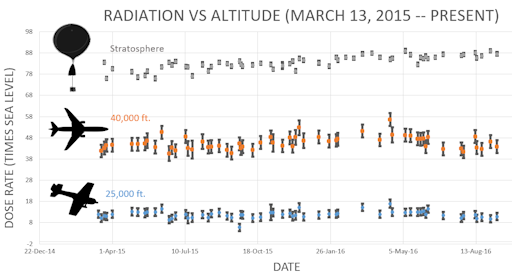
This plot displays radiation measurements not only in the stratosphere, but also at aviation altitudes. Dose rates are expessed as multiples of sea level. For instance, we see that boarding a plane that flies at 25,000 feet exposes passengers to dose rates ~10x higher than sea level. At 40,000 feet, the multiplier is closer to 50x. These measurements are made by our usual cosmic ray payload as it passes through aviation altitudes en route to the stratosphere over California.
What is this all about? Approximately once a week, Spaceweather.com and the students of Earth to Sky Calculus fly space weather balloons to the stratosphere over California. These balloons are equipped with radiation sensors that detect cosmic rays, a surprisingly "down to Earth" form of space weather. Cosmic rays can seed clouds, trigger lightning, and penetrate commercial airplanes. Furthermore, there are studies ( #1, #2, #3, #4) linking cosmic rays with cardiac arrhythmias and sudden cardiac death in the general population. Our latest measurements show that cosmic rays are intensifying, with an increase of more than 13% since 2015:
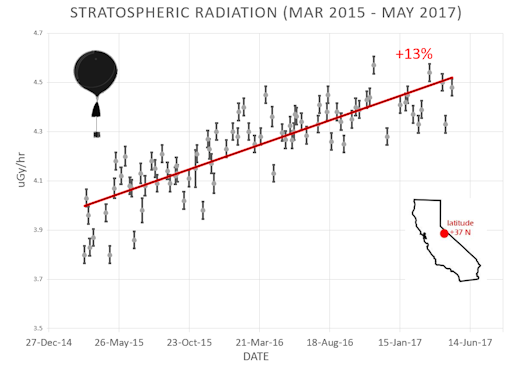
Why are cosmic rays intensifying? The main reason is the sun. Solar storm clouds such as coronal mass ejections (CMEs) sweep aside cosmic rays when they pass by Earth. During Solar Maximum, CMEs are abundant and cosmic rays are held at bay. Now, however, the solar cycle is swinging toward Solar Minimum, allowing cosmic rays to return. Another reason could be the weakening of Earth's magnetic field, which helps protect us from deep-space radiation.
The radiation sensors onboard our helium balloons detect X-rays and gamma-rays in the energy range 10 keV to 20 MeV. These energies span the range of medical X-ray machines and airport security scanners.
The data points in the graph above correspond to the peak of the Reneger-Pfotzer maximum, which lies about 67,000 feet above central California. When cosmic rays crash into Earth's atmosphere, they produce a spray of secondary particles that is most intense at the entrance to the stratosphere. Physicists Eric Reneger and Georg Pfotzer discovered the maximum using balloons in the 1930s and it is what we are measuring today.
| | The official U.S. government space weather bureau |
| | The first place to look for information about sundogs, pillars, rainbows and related phenomena. |
| | Researchers call it a "Hubble for the sun." SDO is the most advanced solar observatory ever. |
| | 3D views of the sun from NASA's Solar and Terrestrial Relations Observatory |
| | Realtime and archival images of the Sun from SOHO. |
| | from the NOAA Space Environment Center |
| | fun to read, but should be taken with a grain of salt! Forecasts looking ahead more than a few days are often wrong. |
| | from the NOAA Space Environment Center |
| | the underlying science of space weather |
 | Reviews here can help you to pick up best memory foam mattresses. |
| | These links help Spaceweather.com stay online. Thank you to our supporters! |
| | | | | | |

